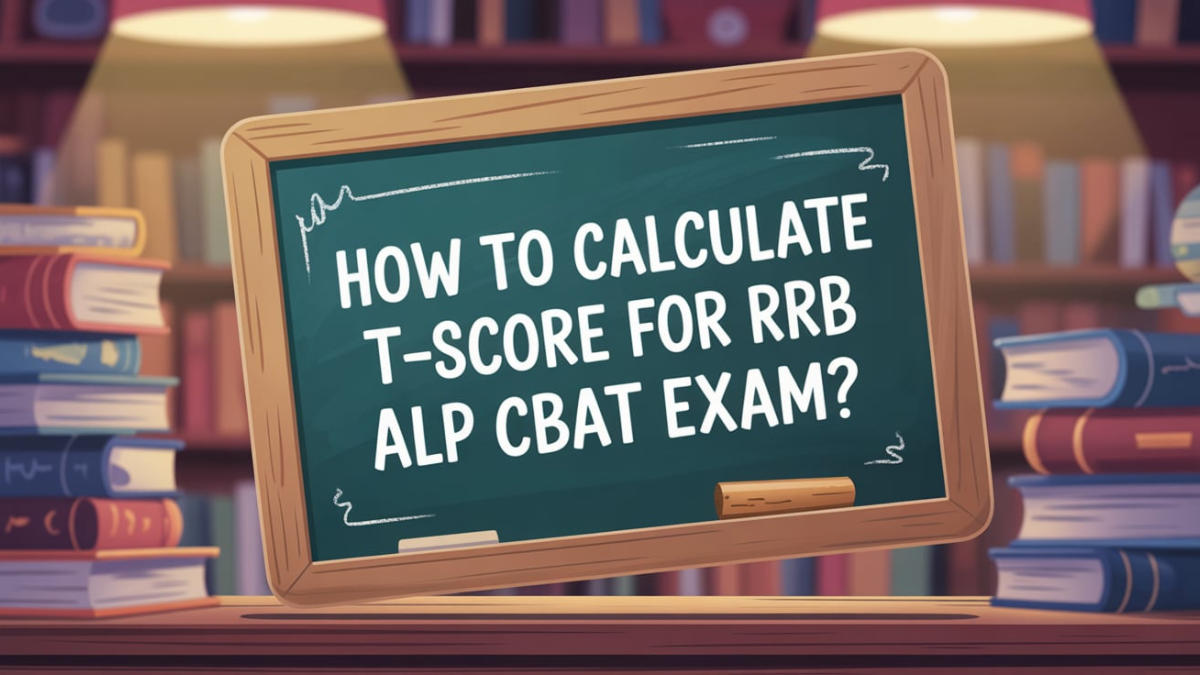The RRB ALP CBAT (Computer-Based Aptitude Test) is a key part of the selection process for the post of Assistant Loco Pilot in Indian Railways. It is not just about answering questions correctly, but also about meeting a specific performance standard known as the T-score. Unlike traditional exams, the CBAT uses the T-score to evaluate and compare each candidate’s ability fairly across all exam shifts and regions. In this article, we explain in detail what the T-score is, how it is calculated, and why it is crucial for candidates to understand this scoring system.
What is the T-Score in the RRB ALP CBAT?
The T-score (Transformed Score) is a standardized score that indicates how well a candidate performed in comparison to others. It is not simply the marks you score in the test. The T-score is used to bring all scores onto a common scale so that performance can be compared fairly, even if exams are conducted in multiple sessions.
The T-score helps ensure that candidates are assessed on their relative performance, taking into account the difficulty level and overall performance in each test.
Why is T-Score Important?
- A minimum T-score of 42 is required in each test of the CBAT to qualify for the next stage.
- The final merit list is prepared by combining the CBT scores (70% weightage) and the CBAT scores (30% weightage).
- The T-score system ensures fairness for all candidates appearing in different shifts or regions.
How to Calculate T-Score?
The T-score for the RRB ALP CBAT is calculated using this formula:
T = 50 + 10 × (X – Mean) ÷ SD
Where:
- T = T-score
- X = Candidate’s raw score in the test
- Mean = Average raw score of all candidates who appeared in the same test
- SD (Standard Deviation) = The measure of how much the scores deviate from the average
Example of T-Score Calculation:
Let’s say:
- Candidate’s Raw Score (X) = 20
- Mean Score = 14
- Standard Deviation (SD) = 3
Now,
T = 50 + 10 × (20 – 14) ÷ 3
T = 50 + 10 × (6 ÷ 3)
T = 50 + 10 × 2
T = 50 + 20 = 70
So, the candidate’s T-score is 70 for this particular test.
How to Calculate the Composite Score?
The Composite T-score is calculated when the CBAT battery includes five tests.
Example:
- Assume a candidate’s total T-score in five tests is 300.
- Maximum possible T-score is 400 (assuming the highest T-score in each test is 80).
Composite Score = (Candidate’s T-Score ÷ Maximum T-Score) × 30
Composite Score = (300 ÷ 400) × 30 = 22.5
The composite score is then combined with the CBT score in the final merit list.
Can T-Score Be Negative?
Yes, T-score can sometimes be less than zero if a candidate’s raw score is far below the average. This is rare, but possible.
Example:
- Candidate’s Raw Score = 0
- Mean Score = 40
- Standard Deviation = 5
T = 50 + 10 × (0 – 40) ÷ 5
T = 50 – 80 = -30
This shows that a very low raw score can result in a negative T-score.
Key Rules for T-Score and CBAT:
- Candidates must score at least 42 T-score in each test to qualify.
- No reservation is provided in the Aptitude Test.
- No negative marking applies in CBAT tests.
- The cut-off criteria for the Aptitude Test are uniform across all RRBs.
- Candidates qualifying in CBAT must also pass the medical examination to be considered for final selection.
Understanding the T-score calculation is very important for candidates appearing in the RRB ALP CBAT exam. It helps candidates accurately evaluate their performance and understand how the Railway Recruitment Board selects candidates fairly. To prepare well, candidates should practice regularly, improve accuracy, and aim to achieve scores above the average to ensure a higher T-score in each test.




 RRB ALP CBAT Shortlisting 2025: Importan...
RRB ALP CBAT Shortlisting 2025: Importan...
 RRB NTPC Graduate Level Answer Key 2025 ...
RRB NTPC Graduate Level Answer Key 2025 ...
 RRC ER Apprentice Recruitment 2025 Notif...
RRC ER Apprentice Recruitment 2025 Notif...




 Adda247 Job portal has complete information about all Sarkari Jobs and Naukri Alerts, its latest recruitment notifications, from all state and national level jobs and their updates.
Adda247 Job portal has complete information about all Sarkari Jobs and Naukri Alerts, its latest recruitment notifications, from all state and national level jobs and their updates.